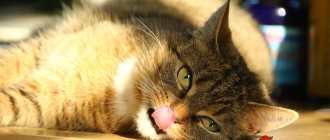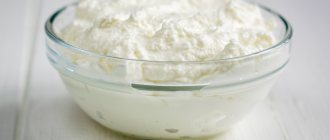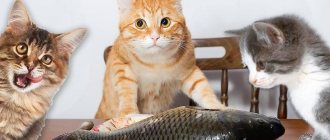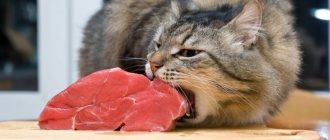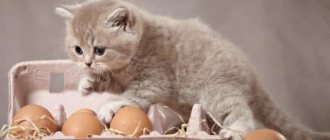Milk for kittens is a valuable, nutritious liquid that they receive from their mother. When the cat stops feeding the baby, he switches to solid food. The body reduces the production of the enzyme responsible for digesting milk. If you give your baby cow's milk instead of age-appropriate food, it may cause stomach upset.
Features of nutrition and digestion in kittens
Newborn kittens receive from mother's milk all the substances necessary for development. Cow and goat are not suitable because they do not contain the required amount of fat, protein, calories, and amino acids.
The milk that newborn kittens receive from their mother on the first day after birth not only transfers nutrients. The liquid contains antibodies that help babies fight viruses and bacteria that are dangerous specifically for cats.
A few days after birth, the amount of protein and fat in cat's milk increases. The latter contribute to the development of the nervous system of babies. Towards the end of feeding, the composition of the liquid changes, preparing the baby’s body for the transition to wet, then solid food of a carnivore.
What is better – natural food or dry food?
The debate about what is healthier – ready-made food or natural food – continues unabated. Dry granules and pates come to the rescue when the owner does not have time to prepare complex and healthy recipes. In addition, industrial feeds undergo a number of tests, so the composition of the product, if not ideal (preservatives, thickeners, etc. are present), is then balanced. Feeding natural foods also has a number of advantages:
- well absorbed by the animal’s body;
- is as close as possible to the natural needs of carnivorous predators;
- does not contain ingredients harmful to cats - salt, sugar and others.
The only negative is that you need to prepare food for the cat separately, since adding seasonings and spices for taste is unacceptable. In addition, you need to regularly give vitamin complexes.
Why cats can't have milk
Kittens grow very quickly and gain weight, so up to 12-16 weeks, food should be high-calorie and not contain components that disrupt the functioning of the digestive tract. First of all, this applies to cow and goat milk.
Lactose intolerance in cats
Dairy products contain lactose, a type of sugar that consists of glucose and galactose. It imparts sweetness to the liquid, which is an advantage of a milk drink for humans. But cats' taste buds do not respond to it.
Moreover, with age, the digestive system of pets reduces the synthesis of the lactase enzyme, which helps process lactose. Excess lactose is retained in the body, settles in the intestines and begins to interact with bacteria. Therefore, diarrhea and bloating in cats is the main sign of lactose intolerance.
Interesting fact: cat milk contains much less lactose than cow's and goat's milk - 3.4% versus 4.6%.
Milk in the diet of adult cats
Cats are carnivores, 70% of their diet should be meat, and dairy food cannot replace it. Some pets tolerate the product normally, without diarrhea or bloating. But due to the lack of necessary nutrients, there is no point in giving a milk drink to adult cats.
Features of feeding little fluffies
From the moment of birth until 2-3 months, a kitten cannot live without mother's milk. It provides him with a full range of vitamins and nutrients so necessary for the development of the cat’s immune system. In situations where at such a moment the kitten is left without a mother, the owners also need to independently begin to accustom it to “adult” food, continuing artificial milk feeding.
To avoid such situations, it is so important to leave kittens with a nursing cat until at least 3 months of age. Be careful, if you were given or sold a month-old kitten, then most likely you are faced with people who do not have the slightest idea about the norms of breeding and selection. In such situations, your young pet will need constant and very careful monitoring by veterinarians, because there are no guarantees that the baby is healthy, and there cannot be.
Upon reaching the first month of the baby’s life, the moment comes when a caring owner needs to begin to care for him more carefully and prepare special complementary foods for him. Under natural conditions, the mother cat herself senses when the right moment comes and begins to accustom her babies to the food she is accustomed to. However, be extremely careful. A large amount of unusual food often leads to problems with the gastrointestinal tract, which can cause severe constipation or, even worse, diarrhea (most often this is what causes the death of kittens up to a year old).
The most important thing to remember and understand is that at such a young age the baby needs breast milk or its substitutes (we’ll talk about them separately). And any complementary foods should be introduced in small portions and with great caution. In addition, make sure that the kitten eats at least 4-5 times a day. Complementary foods should be given in very small portions, otherwise your pet will turn into a funny, but not very healthy ball.
Another rule: one day - one new product. After introducing any new element into the diet, you need to observe changes in the kitten’s behavior for about a day. So, at the first sign of diarrhea, vomiting, weakness or constipation, you should immediately stop using this product and immediately seek veterinary help. In addition, at least 3-4 days should pass between the introduction of new batteries. It is also important to provide the baby with free access to drinking water.
Can cats be given milk?
Do kittens get milk? Older babies who have switched to wet and solid food should not be given cow's or goat's milk. This usually happens by 8-10 weeks. Cats will not refuse dairy food, since the memory of the “taste of childhood” remains on the subconscious level.
Can kittens have cow's milk?
The maximum fat content of cat's milk is 10%, cow's milk is 3.6%. Can a small kitten be given cow's milk? No. It is unable to replace mother’s milk for a newborn, and is not needed for older pets. Moreover, the product cannot be given as the main food.
Cow's milk may not provide all the nutrients needed to keep your pet healthy. The fat present in the liquid contributes to weight gain and stomach upset in an adult cat. The low-fat product does not contain vitamins A and D, which help calcium and protein to be absorbed. This has a bad effect on the skeletal system.
Can kittens have goat milk?
Goat product contains more minerals and vitamins than cow product. It is fattier than cow's milk (6%), but this is not enough for a kitten. Goat milk has a little less lactose, so it is absorbed a little better than cow milk. However, once the kittens are on solid food, milk should be stopped.
The veterinarian can recommend a product for feeding a newborn kitten, giving a recipe for preparing the mixture. It is not recommended to give it in its pure form, since it does not contain many substances necessary for the normal development of the pet.
Can a kitten have milk from the store?
Is it possible to give a kitten store-bought milk? No. Mostly cow milk is sold in supermarkets and is not suitable for pets. Pasteurized products are especially harmful to cats. Studies have shown that it causes skeletal abnormalities, developmental defects and reproductive problems.
Moreover, do not buy cheap goods. Usually this is a low-quality product, where 2-3 tablespoons of dry powder are diluted with a liter of water, and there is not even a smell. A newborn will not benefit, and a grown pet will not need such food.
Can a kitten have powdered milk?
Pet stores sell dry food - cat milk substitutes. They can be given to kittens up to 8 weeks old if they are left without a mother or there is not enough milk. If there is no substitute on sale, the situation is critical; regular milk powder cannot be given. Call your veterinarian, who will tell you exactly how to prepare a formula for your newborn pet.
First feeding
Starting from 3 weeks of age, kittens begin to be offered “adult” food. To avoid overloading the digestive tract, do this very carefully and gradually.
Unusual food is given little by little, starting with feeding once a day and increasing the number of complementary foods to 3 times a day over 7-10 days.
All food is given to babies in the form of warm puree.
Homemade food
You can start feeding small pets with natural protein products. The most suitable ones would be:
- Shaved veal. To obtain scraping, meat that has been frozen for 24-48 hours is scraped with a knife on a cutting board to form lamellar pieces. The initial size of the meat portion is comparable to the size of a pea.
- Baby meat puree in small jars.
- Liquid, well-cooked milk porridge (rice and oatmeal).
- Cream with a fat content of 9-10%.
- Fresh low-fat cottage cheese without additives.
Industrial rations
Special dry food and canned food are developed for small kittens in the 1st growth phase and ensure a safe transition from dairy food to adult food. They contain proteins, fats, vitamins and minerals that ensure the proper development of the kitten, but do not create a burden on the immature digestive system.
According to breeders, the leader in this area is Royal Canin Babycat 34.
Its small pieces have a delicate texture, quickly swell in water and turn into a nutritious paste.
Also watch the video on how to feed a newborn kitten without a cat:
What and how to feed a small kitten
If you picked up a kitten on the street or the cat does not have milk, the ideal option is to find a wet-nurse cat. To do this, ask your friends, advertise on social networks.
What kind of milk should be given to newborn kittens if a wet nurse has not been found? Buy kitten replacement from your veterinary pharmacy, which can be sold in liquid or dry form.
When a substitute is not sold in your city, ask your veterinarian how to prepare formula for feeding a kitten and what kind of milk to feed the kitten. You cannot feed your baby regular cow or goat milk; it must be mixed with yolk. Moreover, do not give condensed milk, the composition of which leaves much to be desired.
How to feed a newborn kitten
The pet must be fed from a special bottle with a nipple, which can be purchased at a pet pharmacy. If it is not there, you can take a pipette or syringe without a needle. In the second case, the mixture must be squeezed out slowly, otherwise the liquid may enter the trachea.
How much milk to give a kitten
A newborn kitten needs to be fed every 2 hours. You need to give:
- 2-3 ml of mixture per 1 feeding in the first three days of life;
- from days 4 to 7, the dose should be increased to 5 ml;
- at the age of 6-10 days – 5-7.5 ml.
Then the frequency of feedings decreases:
- from 11-14 days they give 10-12.5 mixtures, feeding every three hours.
- from 15-21 days – 10 ml of the mixture 8 times a day.
- from 21 days, give 7.5-25 ml 3-4 times a day, begin to introduce solid food.
Feeding instructions
- Dilute the mixture according to the instructions, heat in a water bath.
- Place a cloth on your knees, place the baby on his stomach, slightly raise his head.
- Give him a pacifier with a bottle.
- If you take the pacifier away prematurely, the baby will crawl and squeak. When he is full, he turns his face away and falls asleep.
- After feeding, remove any remaining food from the baby's fur.
- Place your pet on its back and stroke its tummy to start the process of digesting food.
- To avoid constipation and stimulate peristalsis, massage the kitten’s tummy and anus. If it doesn’t help, you can give an enema, but for the first time ask to do it yourself.
Caring for newborn and older kittens
To create comfortable conditions for furry babies, you need to take care of their place of residence. A large basin or cardboard box will serve as a “dwelling”, but you will have to constantly ensure that it does not get wet. For this purpose, absorbent material is purchased that absorbs excess moisture.
In the first days of life, kittens especially need warmth, so it is advisable to install a heater near their place of residence. If you don't have one, use a heating pad wrapped in a towel or a hot water bottle. Don’t forget: the minimum ambient temperature in the first two weeks of a baby’s life is kept at 30° C. After 14 days, lower the temperature to 24° and do not change it for another three weeks.
At three weeks of age, babies begin to try to walk: be careful that they do not fall out of their nest and get injured. The first walks should take place under your watchful supervision.
Try not to let kittens onto the carpet: they do not yet know how to retract their claws and therefore constantly cling. In worst cases, the baby may be injured.
At the fifth week of life, kittens see well and move actively. Then they are introduced to the first complementary foods. By 6 weeks of age they can eat solid food, and at 8-10 weeks they can be given to new owners.
To monitor the development of kittens, you will need an accurate scale. Weighing babies is necessary for:
- calculating the volume of daily portions;
- tracking growth rates.
If your kitten is not gaining weight well, you should consult your veterinarian. Perhaps the baby is malnourished or sick with something.
Question answer
Is it possible to give a one-month-old kitten milk from a non-cat?
There is no point if the mother has enough of it. If your baby is hungry, buy a formula designed for kittens.
Why can't cats be given milk?
The product contains lactose, which the cat's body does not digest well. The result of such feeding is diarrhea, bloating, allergies.
What kind of milk can you give a kitten?
If your baby has already switched to solid food, do not give him a milk drink.
Is it possible to feed a kitten milk?
No. If you have a newborn kitten without a mother, it is better to buy a cat milk replacer.
Should a nursing cat be given milk drinks?
No. It is better to give vitamins and minerals that veterinarians recommend for pregnant and lactating cats.
What foods to give your baby
Proper and balanced nutrition eliminates stunting and other developmental problems. The owner will have to decide in advance what his kittens will eat at 1 month. Mixing “natural” and “drying” negatively affects digestion, causing coprostasis, gastroenteritis and other complications. For your pet’s health, you need to choose only one type of feeding and stick to it for the rest of your life.
Natural food
Feeding “natural” food is much more difficult than dry food. In addition to daily cooking, you will have to take care of purchasing vitamins, since it is almost impossible to reach the norm with food alone. You can feed your little pet:
- boiled quail or chicken yolk;
- minced meat and broth;
- semolina or rice porridge;
- vegetable puree from cabbage, zucchini and pumpkin;
- low-fat kefir, cottage cheese and yogurt.
As an alternative food, you can choose wet and dry food. Any brands of at least premium class, designed for cats under 1 year of age, are allowed.
Wet food
Until the teeth appear, you will have to limit yourself to canned pates. Later you can switch to meat pieces in jelly. These feeds are almost 80% water. They require much less liquid to digest than dry kibble.
Don't pack too big in hopes of saving money. Opened food quickly becomes unusable, so the cat may not have time to eat it before the expiration date.
Dry food
Dry food is good for preventing tartar and is enriched with all necessary vitamins. In addition to the class, you need to pay attention to the manufacturer. Veterinarians do not recommend frequent changes of brands and try not to go beyond a certain brand, even with a therapeutic diet.
At first, it is better to soak the granules in warm water. In this case, even a toothless pet can eat them. When choosing dry food, it is especially important to comply with the water consumption rate. Calculate how much liquid your pet drinks per day and adjust the amount if necessary.
Do I need to continue formula feeding?
Use formulas until the baby is two months old, until he gets used to solid food and begins to eat on his own. After all baby teeth appear, adjust the diet in favor of an adult.
Forbidden food
Do not forget that any food from the human table is contraindicated for pets. Stop any attempts by compassionate relatives to feed your “unlucky” pet pickles, sweets, herbs, smoked meats, flour, fried and fatty foods. A moment's pleasure can turn into a long and expensive treatment.
In addition to the foods listed, avoid feeding:
- pearl barley and millet;
- sorrel, onion and garlic;
- any bones;
- pork;
- mushrooms and potatoes;
- raisins and grapes;
- legumes
Don't believe the myths about the benefits of milk and fish. After a year, cats develop lactose intolerance, accompanied by diarrhea and increased gas production. Fish is fraught with the development of urolithiasis and kidney inflammation, so it is also better to avoid its frequent consumption.
Getting your kitten used to solid food
With the appearance of baby teeth, you can diversify your diet with solid foods. Instead of minced meat, offer your pet finely chopped meat and fish pieces. Use only low-fat varieties, not forgetting about pre-freezing and cooking. Two-stage treatment at different temperatures will eliminate infection by parasites.
Gradually reduce the amount of liquid in porridges by adding meat to them. The baby quickly gets used to this additive in broths and cereals, but you will have to tinker with the individual serving of meat. If the pieces remain in the bowl, then try grinding them into minced meat and offering them again. Having become accustomed to the smell and taste, the cat will begin to eat meat in larger quantities.

